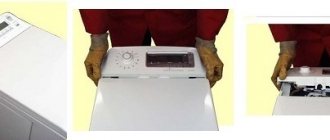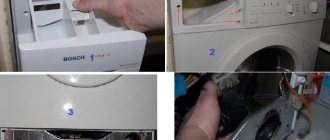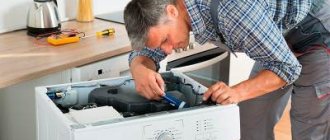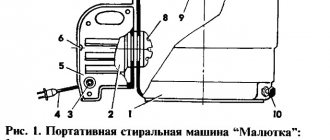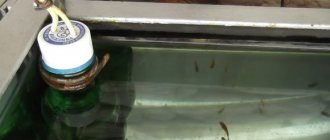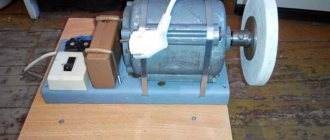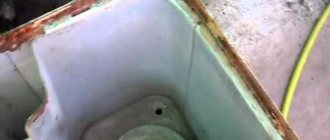Have you encountered a situation where the washing machine is electrocuted, or did you simply decide to inquire about all the nuances of the connection before installing the equipment? In this article, we decided to consider one very important issue that directly relates to connecting washing machines - how to ground a washing machine with your own hands. Next, we will consider the main methods of organizing protection, as well as the advantages and disadvantages of each of them.
Grounding a washing machine: why it should be done
Perhaps the current-carrying parts of the product came into contact with ground, or the electrical components were flooded with water leaking from the tank? The owners see the cause of the defect solely in the washing machine and try to quickly get rid of the dangerous “helper”. But is that the point?
If similar household stories in an apartment or house occur with other electrical household appliances, or after installing the “washing machine” light bulbs begin to burn out frequently, this clearly indicates that the cause of the malfunction is not localized in the unit.
In fact, the problem lies in the mismatch between the technical standards of modern electrical products and the power supply network. The difference is that for normal operation of the unit it is necessary to use a 3-core cable via the TN-S grounding system with phase L, separated by working N and protective PE zero.
In fact, 90% of Russian apartment buildings are equipped with a 2-wire TN-C supply. Phase L and one conductor PEN with a combined working and protective “0” are supplied to the sockets. Under pre-2003 standards, it was not permissible to provide a separate grounding wire for outlets, and the chassis could not be grounded. Therefore, it is necessary to adapt the power supply system to the requirements of manufacturers.
In the apartment
Some people mistakenly believe that only old household appliances with “tired” insulation need to be grounded in case of flashing 220 V alternating voltage to ground. However, the technical solution of new electrical devices initially provides for the presence of a 110 V potential on the metal parts of the case! This is due to the use of a network filter to reduce high-frequency interference, which is used in almost any modern SBT. In this cascade, the phase and zero of the 220 V alternating voltage are connected to the housing through separating capacitors.
If you are experiencing constant tingling and tingling when washing due to the discharge of capacitors, disconnect the output of the midpoint of the surge protector in the power supply circuit of the machine from the housing. Electrical wiring that meets the following requirements is considered to be correctly installed:
- the electrical panel contains a neutral (N) and grounding (PE) bus;
- after the meter, the phase wire with red insulation goes into the RCD, and from it goes to the power socket of the washing machine;
- for connection, only a special socket and copper wires with a cross-section of 1 mm are used for every 2 kW of power;
- N neutral/blue and L phase/blue wires are connected to the pins, and PE ground/yellow-green is connected to the contact pad of the plug.
According to safety regulations, operating the washing machine without grounding in a damp room (bathroom, toilet) is not allowed. When working in a “wet area”, it is necessary to install a moisture-proof socket with a degree of protection IP44.
In a private house
You can create reliable grounding in a private house by laying a multi-core cable from the electrical panel to the electrical outlet using the TN-C-S grounding system.
When using a TT system, all electrical wiring groups are equipped with an RCD with a setting of 10–30 mA. If the wiring is made according to the standards of the Soviet period TN-C according to a two-wire circuit, which allowed for the absence of a grounding wire, the PE conductor from the grounding bus is routed separately. This is less aesthetic than in the first case, but a reliable option. Having your own local area also allows you to create an additional grounding loop in the absence of a ground bus, a description of which will be presented in the next section. You must first verify the need to install grounding or the effectiveness of the existing one; this is done using a measuring device.
To measure, use a multimeter set to voltage measurement mode, and the hand will serve as the “ground”. One probe of the device must be held with your fingers, and the other should be touched to any metal part in the structure of the washing machine. If the device shows “0”, the device is grounded, if 100–110 V, then there is no connection to the ground loop - it is necessary to organize a potential equalization system with the “ground”.
How to create a safe environment in your apartment?
The time of construction of the building is the main factor on which the connection scheme used in the future depends. If we are talking about a new building, then there should be no serious difficulties due to security and connections.
After all, builders usually organize appropriate grounding in such cases from the very beginning. Wiring for electricity will most likely have a third wire that is grounded. Such measures are quite enough to avoid injuries from electric shocks.
It’s another matter if the accommodation is organized in a house built during the Soviet Union. You can’t do this without the help of a specialist. Or the problem can be solved on its own. The main thing is not to leave it completely unattended. In this case, you can use two options.
In the first option, it is assumed that the shield becomes the grounding source. This resource comes to it from outside sources. And from it electricity goes directly to the apartment.
The work is carried out in the following stages:
- Owners place two tires inside the shield. One of them should be zero, and the other should be grounding, with the appropriate designation. It is from these elements that the wires are then laid out, separately for household appliances, and separately for lighting.
- A three-core wire is laid from the outlet that powers the washing machine. The main thing is that the copper section is present. The following nuances are taken into account when connecting.
The neutral or blue wire must connect to the neutral bus. The phase or red wire goes through the RCD circuit breaker, and then connects to the same phase meter.
Finally, the yellow-green wire goes to the ground bus. Grounding elements must not be connected to wires for working with zero. When working with wires, it is important to turn off the electrical power completely.
To perform each step correctly, you will need several types of tools:
- Sharp knife.
- Grounded socket.
- Three-core wire.
- Indicator screwdriver.
- Pliers.
The main thing is to be responsible and attentive to your work. If the actions seem too complicated, then it is better to contact specialists.
The first grounding method is the most reliable. It does not violate legal requirements.
What other solutions are available?
In old houses it often happens that there is no grounding at all. That is, the ground wire inside the panel is not connected. Standard grounding cannot be arranged for those who live on the fifth floor.
How to create additional protection for yourself and your loved ones? One of the available options is the organization of a potential equalization system. The essence of such systems is simple to explain.
Installation inside the bathroom leads to the human body receiving the current. This occurs when two objects capable of transmitting electricity come into contact with each other at the same time.
Creating a potential equalization system eliminates problems. It promotes the appearance of metal wires to connect objects through which electricity is conducted.
Then electricity will not pass through a person when he simultaneously touches the faucet and the washing machine, for example.
The system assumes the presence of an addition, which is the so-called RCD machine. The same applies to the machine gun in the dashboard. In this case, the washing machine simply turns off automatically if a malfunction occurs.
An important point is to use a waterproof outlet. In its absence, it is recommended to completely abandon the idea of installing the device inside the bathroom.
When installing an electrical wiring, you need to use only solid types of wires. When organizing docking, this is done in a special box, after careful insulation for all components.
There is also a simpler option for arranging grounding. Under such circumstances, a grounding wire with a source in the form of a machine body is fixed to a battery or a sewer pipe. But at present the solution is not safe and legal.
There is a good chance that even your neighbors will feel the current when they touch the riser. The surface of the pipes suffers from the formation of cracks, which ultimately leads to flooding.
Source: https://stiralkainfo.ru/ekspluataciya/kak-zazemlit-stiralnuyu-mashinu-esli-net-zazemleniya.html
How to ground a washing machine with your own hands: all the methods
The grounding system includes a grounding loop with a grounding conductor and wiring to electrical receivers, including a washing machine in the facility premises.
Ground loop
In the absence of a main grounding bus, the electrical panel can be supplied with “ground” from a grounding device assembled with your own hands in the courtyard of the house. A grounding loop located no closer than 1.0 m from the wall on the wettest side of the building will provide resistance to current spreading in the ground of about 30 ohms:
- We dig a trench in the shape of an equilateral triangle with sides 3 m long, 1 m deep, 50–70 cm wide for the ground electrode. Additionally, we dig a groove 0.8 m deep from the trench to the electric meter for supplying the grounding conductor.
- We hammer 3 m long steel corners 40x40x5 mm into the vertices of the triangle, not reaching the bottom of the trench 15–20 cm.
- We weld 40x4 mm steel strips around the perimeter to the electrodes protruding from the ground.
- A Ø 10 steel rod selected according to the length of the distance to the electrical panel, acting as a grounding conductor, is welded at one end to the grounding conductor.
- We weld an M6 fastening bolt to the other end of the rod to connect it to the PE bus of the electrical panel.
- We place the grounding conductor in the groove and fill it with soil together with the trench.
Potential equalization system wiring
Do-it-yourself arrangement of a potential equalization system in a house or apartment consists of a complete reconstruction of the supply network with the replacement of the 2-core wire L, N with a 3-core analogue. A less expensive option involves forwarding one PE wire from the grounding bus to the electrical points.
Grounding the washing unit body
If upgrading the electrical wiring with the transition to the TN-S grounding system is delayed, and it is necessary to operate the washing machine, you can make an individual connection for the electrical appliance. We connect a single wire with a copper core Ø 2.0–2.5 mm to the PE ground bus of the electrical panel, then we forward it to the socket, put it under the glass and connect it to the protective terminal.
Grounding conductor color
In order to ground a washing machine without errors, it is worth knowing the requirements for the colors of grounding conductors. On sale you can find wires of various options, which are made for convenience and safety.
When arranging wiring, as a rule, the following wires are used:
- Red - phase;
- Blue - “zero”;
- Yellow-green - “earth”.
In practice, colorless or white conductors are used. In the latter case, the ground wire is located in the central part.
With this approach it is difficult to make a mistake, because when connecting you need to connect the wires taking into account the color - red to red, blue to blue. As for the yellow-green “ground” wire, it needs to be “planted” on the ground terminal.
Dangerous grounding options
There are several methods of grounding that should not be used if you are not sure that you will do everything correctly.
Grounding the old-fashioned way
The easiest way to create a ground connection is to connect one end of the wire to the body of the washing machine using a bolt on the back wall.
Screw the other end of the wire to a water supply or heating pipe, cleaning the contact area. This method is effective and quite workable, but has its drawbacks:
- it is unsafe - even neighbors who touch the riser can “feel” the effect of electric current;
- the use of pipes as grounding conductors stimulates destructive processes; cracks intensively form on the walls, which can lead to flooding of the facility.
This solution to the problem is prohibited by electrical safety rules.
Connection with zero in the socket
In order to save money, some electricians do not pass the PE wire from the grounding bus, but short-circuit the conductors with the N wire with a jumper directly in the socket; this is prohibited!
The grounding system connects the body of the washing machine to the “ground” and helps protect the “electronic filling” of the product from damage.
Thanks to the normalization of the operation of the network RF filter along the “case” → “ground” circuit provided by product manufacturers. And to protect users, which is important when operating the unit in a damp room.
If the insulation of the wiring of the washing machine is broken, there may be 220 V on the body, so one touch is enough to give a person a good shock, and this is generally a direct threat to health and life.
In addition, grounding will help with voltage surges and when a lightning charge hits a transformer or antenna on the roof of a building. That is why proper connection of the washing machine with grounding is necessary - this is safety for you and your equipment.
